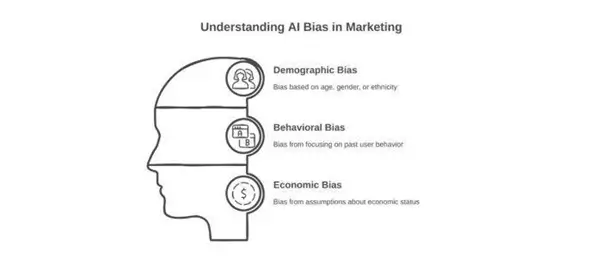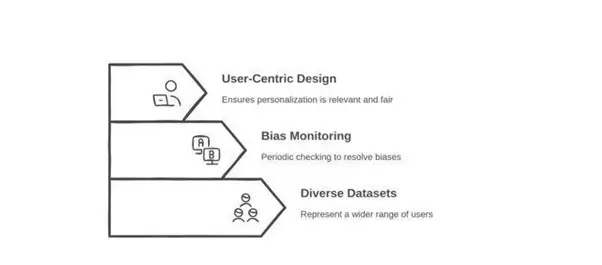Imagine browsing online and suddenly a website seems to “know” exactly what you’re looking for: the right product at the right price at just the right time. It’s as if the brand speaks your language. Such is the power of AI in marketing-it transforms the way we personalize experiences for users. But the catch is, with increased usage of AI in marketing strategies, we need to also make sure it is used ethically. Personalization has become a new paradigm of expectation. Consumers look for not just a good product but an experience molded around his or her personal preferences and needs. Marketers are constantly trying to meet those expectations. However, offering personalized experiences is more than just delivering relevant content. It is also about considering the fairness of those experiences. That is where ethical AI comes in.
The question might arise: can you really have ethical AI marketing? Definitely. Look at examples like IBM, whose ethical AI frameworks valued transparency, fairness, and accountability, which successfully secured consumer trust in the company and, thus, loyalty from its customers. According to a study by Accenture, 91% of consumers are more likely to shop with brands that give relevant recommendations. And while this shows just how important personalization is, it also shows just how huge an opportunity and burden marketers have. The takeaway is that ethical AI is not just a “nice to have.” It is critical for the development of more inclusive and effective marketing strategies.
In this blog, we’ll explore how ethical AI can avoid bias in personalization and conversion rate optimization (CRO). With real-world experiences, propose some actionable strategies, and give clear recommendations for ensuring that your AI-based marketing is efficient without compromising fairness.
Understanding Bias in Web Personalization and CRO
When the programmed algorithm in AI or any other software gives certain groups or results unjust advantages based on biased data, then such bias is called AI bias. In connection with marketing, such bias can lead to inadvertent misalignment with reality and create adverse user experiences, which commonly exhibit both discrimination and exclusion. Most AI tools are designed to optimize and personalize user experiences. However, the absence of moral safeguards might expose destructive patterns.
One such example is DALL-E, a generative AI tool which was found to have a preference for the light-skinned when generating images. While this is not a deliberate bias, it helps in showing how AI systems can perpetuate stereotyping in society. This understanding assists in making us aware of the possible ways in which bias can harm, particularly consumer trust, and exclusion.
Types of Bias to Explore
There are several forms of bias that marketers should consider when using AI for personalization and CRO:
Demographic Bias
When AI systems unintentionally favor or exclude certain groups based on demographic data like age, gender, or ethnicity, it is termed demographic bias. This might be the case where an algorithm recommends products mostly for one gender or one age group, failing to cater to others. This leads to uneven product visibility, leaving some customers limited in their choices or not getting any recommendations relevant to them.
This could be the case when an e-commerce site recommends products for customers tailored mainly for men because their historical data leans on a certain demographic. This deprives customers outside that demographic of an inclusionary shopping experience, which could also transform into alienation toward some customers.
Behavioral Bias
Behavioral bias results from AI systems that overly use past user behavior data to create an “echo chamber” effect. When an algorithm focuses on showing users products similar to what they already use, their exploration will be limited. Although this might increase short-term conversions, it could, in turn, deprive the customer of exposure to other products that he or she might have found more attractive.
For instance, a regular customer of eco-friendly products might be consistently instructed by the AI to consider eco-friendly products only; unfortunately, this approach would eliminate any option which could have been possible the user could go by a different category or product at a later stage, which could lead to suppressing additional growths in terms of user engagement and conversion.
Economic Bias
An economic bias occurs, for example, when an AI algorithm presents disparities in pricing or product recommendations based on economic factors. For instance, it might assume that a customer coming from a more affluent area is willing to pay more for an expensive item and offer only expensive alternatives to him or her, while someone from a lower-income area will be offered a less-costly alternative.
In this case, if AI systems began to do the pricing or make the recommendation automatically, with the pricing or recommendation calibrated to some presumptions about the user’s financial situation, this could be especially worrying. Since it creates an unfair situation and can potentially damage a brand for customers who might feel manipulated or excluded. The case of Cambridge Analytica is a reminder of how misuse of any personal data may negatively influence user experiences, thus tarnishing a specific brand.
Principles of Ethical AI in Personalization
In order to ensure that AI-driven operations create more inclusive and effective personalized experiences, brands must follow clear ethical guidelines. The described frameworks are based on three main principles: transparency, in which AI decision-making just be comprehensible to users and communicated transparently to them; fairness, where AI treats user groups equally and does not inherently favor or discriminate against any group; and third, accountability, which implies that marketers need to take the responsibility for AI outcomes and rectify bias if any.
Microsoft is a great example of a role model having embedded responsible AI into business strategy. The company has worked on its transparency, fairness, and accountability, which has earned consumer trust and proving that ethical AI-not only adds brand loyalty but also drives business growth.
Key Strategies:
Developing ethical AI personalization is not just about compliance; it is about ensuring that every user has a fair and useful experience. It all begins with a few principles. First, AI needs to be trained on sufficiently diverse datasets to represent a wider range of users. Second, ongoing bias monitoring helps in the periodic checking of AI systems to catch biases or injustices and resolve them before they affect any real user. Finally, user-centric design ensures that the personalization is always relevant and fair and works for the end user.
These are not just nice-to-have ideas; there is real-world evidence behind them. In fact, 73% of customers expect brands to understand their unique needs, according to Salesforce. This means that when businesses invest in ethical AI for personalization, they create more meaningful and authentic relationships with their customers.
Practical Approaches to Bias-Free Personalization
Marketers require action-oriented strategies for creating ethical and inclusive frameworks of personalization. The strategies must focus on reducing bias while keeping the relevancy of the user experience.
Actionable Strategies for Marketers:
Diverse Data Collection
The first step should be collecting as much diverse user data as possible from a wide range of demographic distribution, types of behavior, and preferences. That will produce accurate, balanced recommendations. Surveys and cross-platform tracking can provide insight into users, whereas at the same time respecting privacy and complying with regulations like GDPR. For example, IBM regularly conducts bias audits to ensure that its advertising is as inclusive as possible.
Intelligent Segmentation:
In conducting user segmentation, you should move beyond purely demographic targeting and incorporate behavioral and contextual intelligence in developing more sophisticated segments. This allows for the delivery of personalized content in light of real-time actions for providing more relevant experiences. For instance, a user showing interest in a product category may receive tailored recommendations based on his/her behavior pattern during that very session, rather than the generic past demographics.
Dynamic Personalization
Adopt dynamic personalization, and let recommendations be fine-tuned in real-time based on user behavior. This guarantees that the experience is always relevant, and adapting quickly to changes of preferences avoids bias. Keep those adjustments flexible while treating user privacy by GDPR guidelines.
Web personalization platforms make these strategies more practical and scalable for marketers. By automating the act of collecting data, a more diverse and representative dataset can be assembled and, thus, bias risk may be diminished from the start. By intelligent segmentation tools, targeting can now be fine-tuned beyond demographics, producing meaningful and dynamic experiences for interaction. With adaptive personalization, content and recommendations are being constantly reevaluated in real-time in reaction to user behavior, thus ensuring interactions are relevant without requiring constant manual inputs.
These platforms also present vital solutions for all major data privacy compliance challenges by embedding ethical principles of AI into their frameworks. These tools help marketers wanting to adopt personalization without compromising fairness or efficiency at scale to provide the structure to deliver personalized experience while maintaining trust and transparency.
CRO Optimization with Ethical AI
An ethically designed AI is one that does not just put an end to bias but also attends to enhancement in conversion rates, ensuring that all users undergo an experience that is fair, relevant, and engaging. Making personalization inclusive will lead users into trusting a brand, engaging with content, and completing desired actions. Simple steps like A/B testing across diverse audiences and designing user-friendly experiences make a big difference.
Take Spotify, for instance: they noticed how their recommendations kept users in the same bubble of music tastes. They decided to spice things up in an effort to help people discover a few new artists. Likewise, Airbnb made adjustments in its recommendations so that its search results become much more inclusive across all users. By employing these AI strategies for the good, brands can thereafter enhance consumer experiences and, hence, navigate their way towards real growth.
Final Words
More than just avoiding bias, ethical AI builds trust and improves user experience, yielding better results. Brands that work toward fairness and transparency create stronger customer relationships and see real growth. In the future, personalization will need constant learning and responsible AI. As technologies evolve, businesses should remain ahead of the curve by ensuring that their AI operates for everyone. The time is here to finally push for ethical AI. When pursued the right way, it can help a business scale, drive user engagement, and build a more inclusive digital world.







